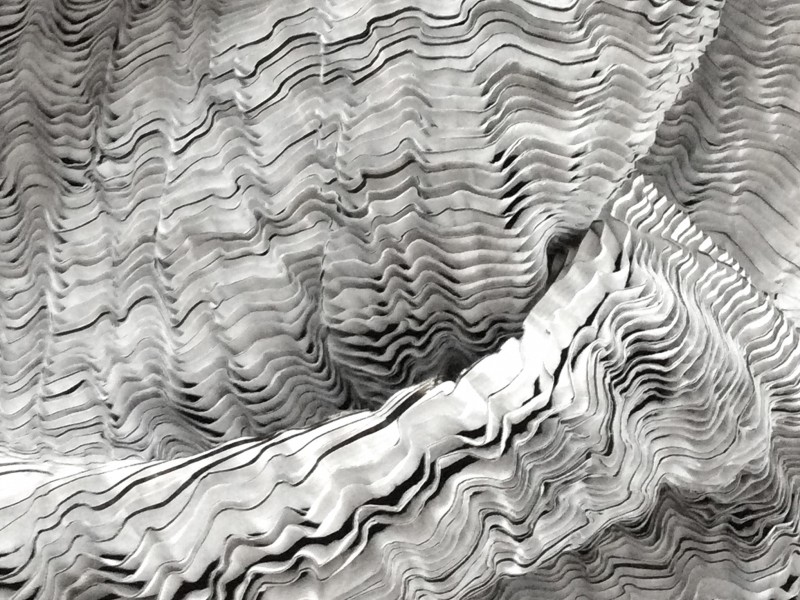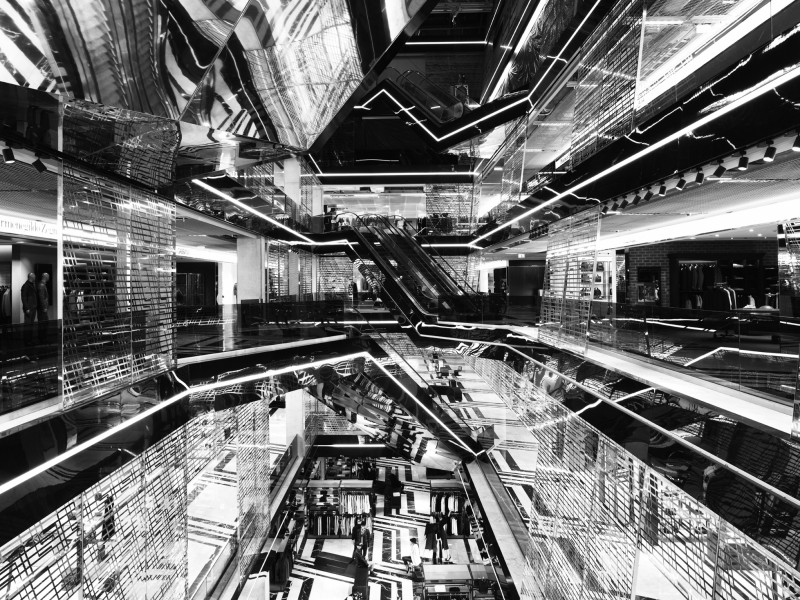Inez van Lamsweerde and Vinoodh Matadin are two names that are quite a mouthful. Between them, the Dutch photographers boast ten tongue-twisting syllables. Like the photographs they produce; fashion images, portraits, advertising campaigns, their names have become synonymous with a space between normal and strange, light and dark, self explanatory and the mysteriously glamorous.
It’s hard to pick up a magazine of any worth these days and not see their work. Bearing trademark clarity and ingenious flair, their pictures jump off the page, grace myriad billboards and filter into popular culture with enormous confidence. When you see their work—precise, beautifully lit, immaculately executed and brought to life by models and actors who know they are in good hands—there is no doubt who is responsible. They straddle the polarising worlds of art and commerce, blurring the lines of which is which, and in this sense they stand alone.
Inez and Vinoodh, as they are known to the wider world, defy easy category, and this ‘otherness’ has served them well, catapulting the duo into the upper echelons of their industry. Emerging from Amsterdam’s Fashion Academy Vogue in the late 1980s, both originally studied design, but Inez shifted to photography when “everything I designed or thought about became an image”. Vinoodh asked her to photograph one of his early collections and later joined her in the art of image making. As they love to recount it, the pair fell instantly in love and have remained together for thirty years. “We can’t do anything without each other,” van Lamsweerde has admitted. “We have the same ideas, the same reference points, it’s as though we became the same person.”
They certainly make a striking pair: exuberant Inez with her owl-like eyes and Pre-Raphaelite hair; alongside shy, quietly handsome Vinoodh, much less comfortable in the spotlight. Apart from Mert Alas and Marcus Piggot, with whom they share a certain sensibility, there are no other ‘duo-photographers’, not least partners, working to such a high level. Inez also remains the only woman of any note taking fashion images in 2016, which seems incredible, but also confirms that talent is what the male-dominated hierarchy of this niche requires. It is difficult, she has said, to keep coming up with the goods, “especially when big fashion houses expect so much. They want to see at least eight fantastic images a day. It’s not always been like this, and it certainly puts people, especially my assistants, off entering the profession.”
Fuelling the idea that career trajectories are mapped by leaps of faith, the duo were early exponents of computer manipulation. In 1993, as burgeoning artists in New York, they experimented with new software and were early adopters of Paintbox technology. Taking this innovative tool to extremes, they photographed a series of nudes whose nipples and genitalia were digitally smoothed and removed. Redolent of the disturbing work of British artists Jake and Dinos Chapman, Thank You Thighmaster attempted to blend horror and elegance with a tongue-in-cheek ultra modernity. A further series, the hyper-unreal Final Fantasy, morphed children’s faces into portraits of sexual desire, cementing a reputation for risk taking and social commentary. “The obvious fakeness shows an internal experience on the surface,” said van Lamsweerde at the time.
As the art world circled, hungry for the pair’s audacious output, the fashion industry also took note. In 1994, a landmark story for The Face, republished from Amsterdam’s BLVD magazine, saw further experimentation. For Your Pleasure featured models looking as synthetic as showroom dummies, heavily influenced by 1970s nightclub glamour, plastic couture, and all the camp association that embodies. Deftly superimposing their subjects onto stock images, the effect was instant and undeniably mesmerising. One double page spread featured a pair of bike-mounted Euro-twins sharing a popsicle, in reference to the space rocket taking off behind them. Part Fiorucci, part brave new world, what it most definitely wasn’t was grunge—the prevailing back to basics, no-frill genre that dominated the start of the decade.
In essence, Inez and Vinoodh were the antidote to grunge. Van Lamsweerde, the daughter of a notable Dutch fashion journalist, had been attending the Paris shows with her mother from the age of three, inheriting a love of all things flash-bulb worthy. “I was reading French Vogue as a girl because that’s what we had in the house,” she recently declared. “Helmut Newton, Guy Bourdin—these were the photographers that made the biggest impression on me.” There are undoubted similarities to the work of these provocateurs: the campness, high octane sheen, and eye for an arresting image, all attest to shrewd observation. “The pages of Vogue were my point of reference, and what an amazing starting point.”
Matadin cites the work of Ed van der Elsken, a Dutch photographer who created monochrome tableaux of ordinary people in repose, transforming them into B-Movie stars inhabiting real world sets. His influence can be seen in the portraits that Inez & Vinoodh have become increasingly adept at. Van Lamsweerde is also no shrinking violet and refuses to defer to the egos of Hollywood, or the capricious temperaments so common in the music business. Perhaps this is why they have always extracted the best out of their sitters, and why everyone from Clint Eastwood to Björk leave the studio with one of the best images of their career. The big given you always see in their work, shows in the eyes of the person they’re photographing. This allows the image to transcend any field. They are images of human beings, rather than fashion moments, celebrity portraits, or a random beauty attempting to sell you something.
The ability to transcend in this way, has brought opportunities to branch out from the art-directed confines of fashion. It is worth remembering that the duo started out with artistic intent and have shown in commercial art galleries since the early 1990s. “Both worlds can feed off each other but they also keep it independent,” said Matadin in 2006. “We have one foot in one side, and one in the other. Lines blur by adding emotional value to every piece.” What is most apparent is the fact very few photographers or artists have the dual career they enjoy, or the voice they use to direct their immense flights of fancy. At times they are surreal, emotional, playful and confrontational. There are clean lines and dirty surfaces, as many scowls as there are smiles, while androgyny, humanity and the desire to freeze frame the moment presents itself in so many ways.
Colleagues reveal that Inez takes the pictures while Vinoodh ‘steals them’, meaning he can pounce on an idea with alarming synchronicity. They always shoot together, Inez talking to the model, creating a dialogue, so the awareness of the person is focused on him or her. Vinoodh snoops around, shooting from different angles and with varying proportions, usually capturing the more intense moments. They are relaxed in the studio (a virtual second home, with over 150 shooting days per year) because they know either one of them will get the picture—two visions creating a single image. The pair definitely come as a single unit, as identified by their iconic art work Me Kissing Vinoodh (Passionately) in which van Lamsweerde’s contorted face embraces Matadin, who has been digitally removed from the image. While the photograph without Vinoodh was exhibited in galleries, another version with him present and Inez covered in body paint was used as an advertising image for Lanvin Homme. As you can see, in their multi-faceted world anything is possible.
Perhaps the most endearing quality of the dynamic duo, beyond their imagination, their prolific output, or the sheer heart-stopping effect of their art, is their dedication to those around them. From agents to assistants, the production crew who make the world of Inez and Vinoodh spin around so prettily, and a revolving cast of models always welcome in the fold, the vibe appears solid and family-like. Some of these individuals have been with them for over two decades, obviously enthralled by their pioneering spirit.
And nothing appears to daunt them, whether signing with art-god Larry Gagosian for gallery representation; directing videos for Lady Gaga; or dreaming up campaigns for the likes of Chloe, Gucci, Miu Miu and Isabel Marant. “I feel like you can do whatever you want now,” said van Lamsweerde in 2013. “When we started, nobody would look at your portfolio unless you had Linda Evangelista or Naomi Campbell in it, but that’s all changed. You can shoot for Comme des Garçons and H&M back to back and nobody cares as long as the end result is good. I like that flexibility.”
Journalists are prone to ask her if things are easier now, and the answer is always alarmingly frank. “I think the underground has slowly eroded,” she opined in 2014. “Kids don’t have to look too hard anymore, it’s all on the internet. I say go and find your picture, and put your stamp on it. Photography will only thrive if it is original.”
For more visit www.inezandvinoodh.com
Related Features
-
86
-
-
-

